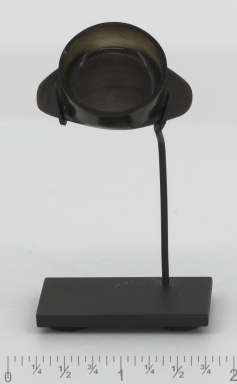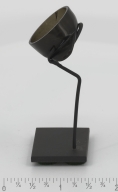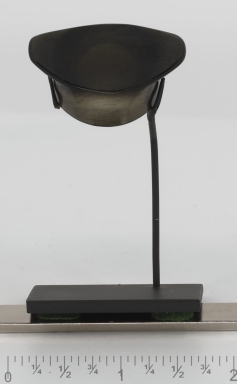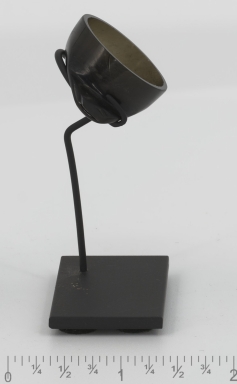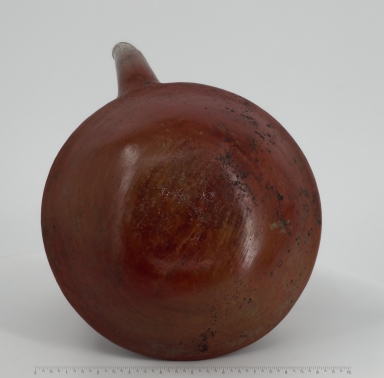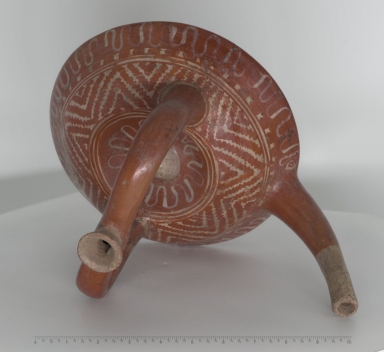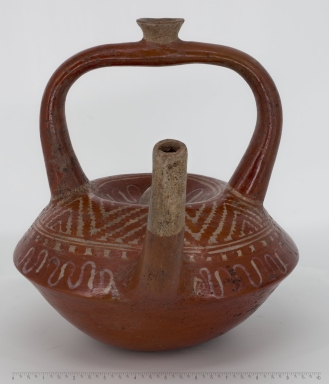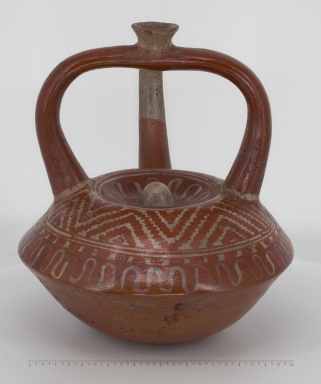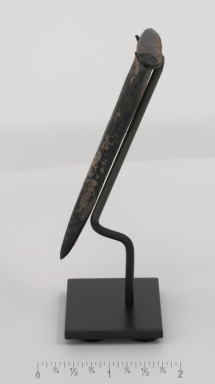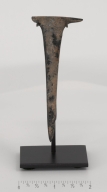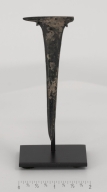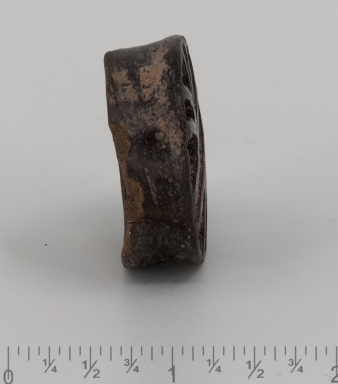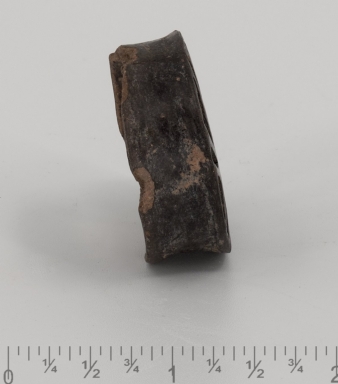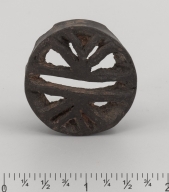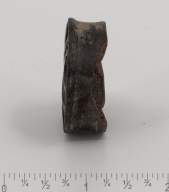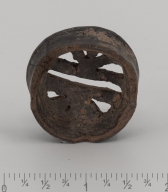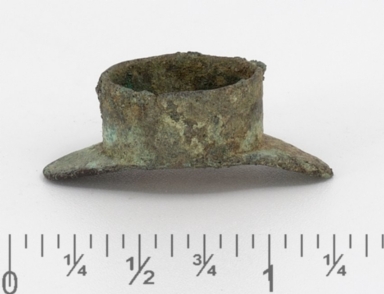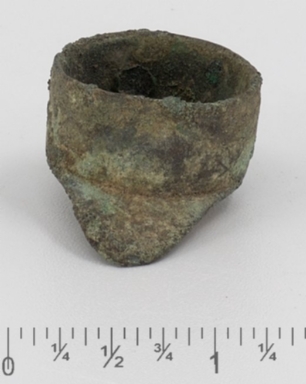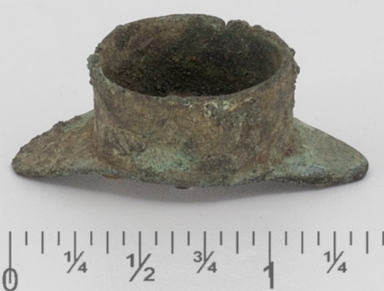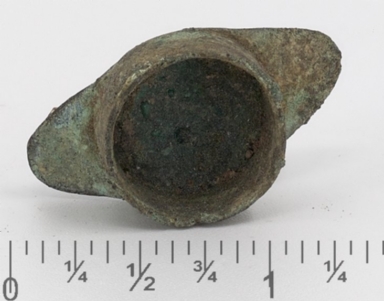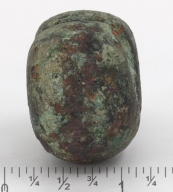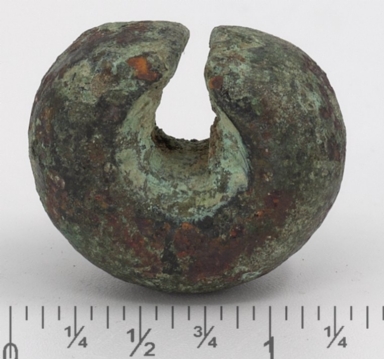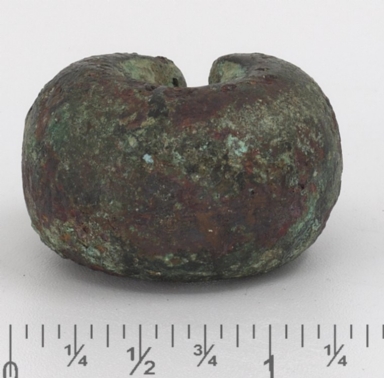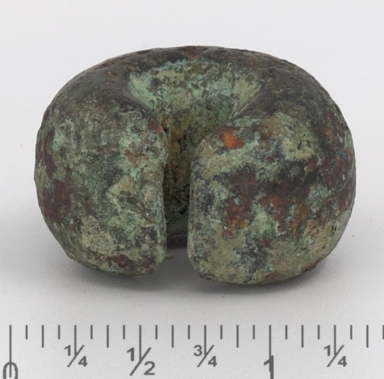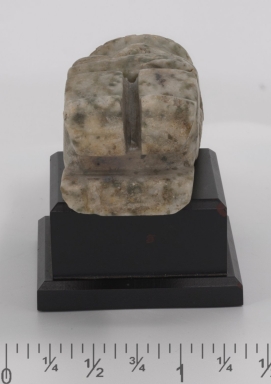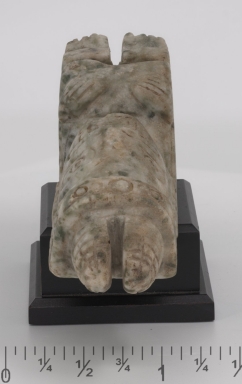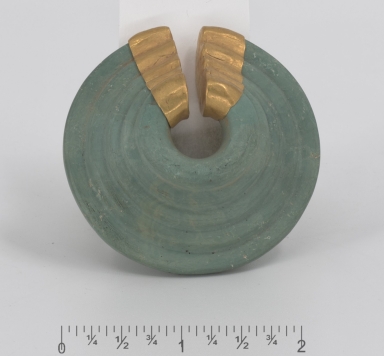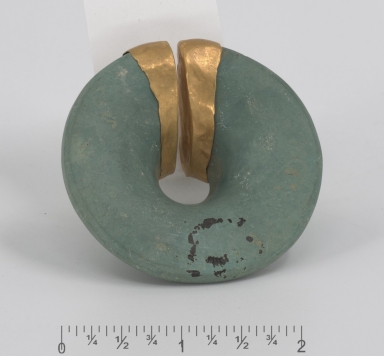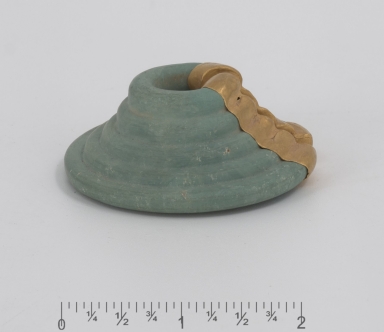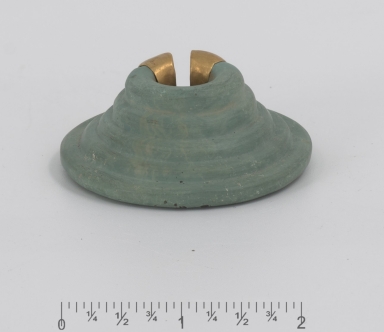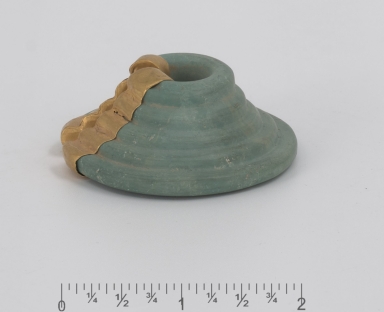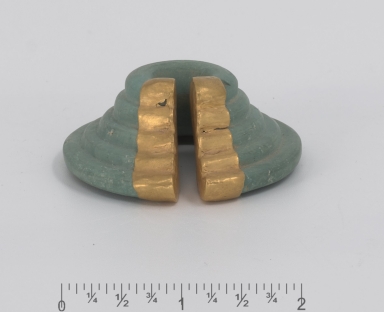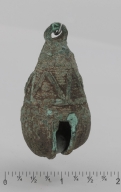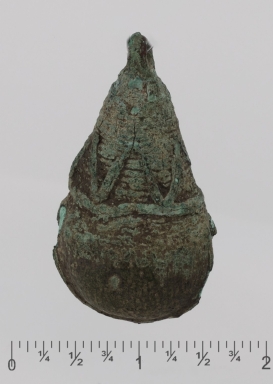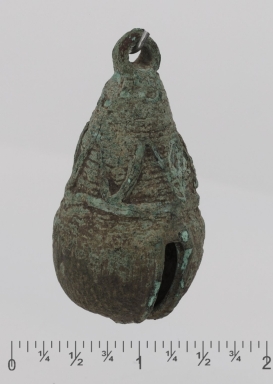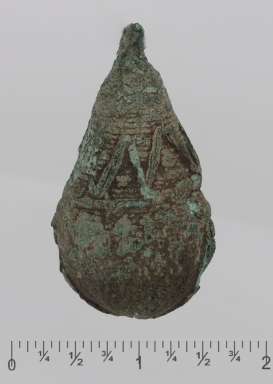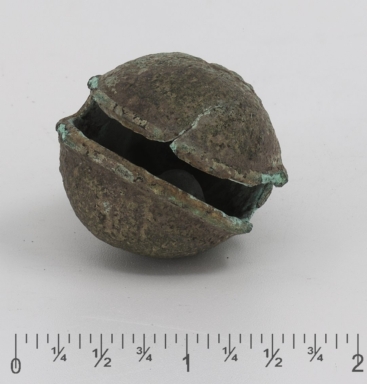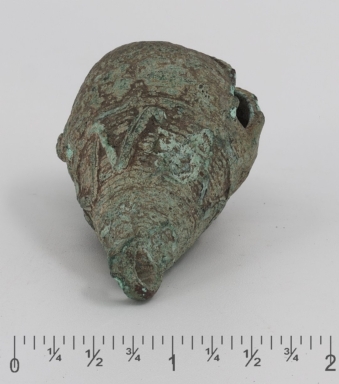Who What Where WhenWHATShow MoreWHERE
|
Title
Three Obsidian Winged Labrets, a
Description
Obsidian is a volcanic glass-like stone cleaves concavely. Working with obsidian requires great skill. The process involves core flaking, pressure flaking, drilling, abrading as well as polishing. It is very labor intesive. Two of the labrets have been inlaid with a white material.
Subject
[Labrets, Jewelry--Mexico, Decoration and ornament--Mexico, Stone carving--Mexico, Art--Mexico, Indigenous peoples--Antiquities]
Date
between 900 and 1522
Title
Three Obsidian Winged Labrets, a
Description
Obsidian is a volcanic glass-like stone cleaves concavely. Working with obsidian requires great skill. The process involves core flaking, pressure flaking, drilling, abrading as well as polishing. It is very labor intesive. Two of the labrets have been inlaid with a white material.
Subject
[Labrets, Jewelry--Mexico, Decoration and ornament--Mexico, Stone carving--Mexico, Art--Mexico, Indigenous peoples--Antiquities]
Date
between 900 and 1522
Title
Three Obsidian Winged Labrets, a
Description
Obsidian is a volcanic glass-like stone cleaves concavely. Working with obsidian requires great skill. The process involves core flaking, pressure flaking, drilling, abrading as well as polishing. It is very labor intesive. Two of the labrets have been inlaid with a white material.
Subject
[Labrets, Jewelry--Mexico, Decoration and ornament--Mexico, Stone carving--Mexico, Art--Mexico, Indigenous peoples--Antiquities]
Date
between 900 and 1522
Title
Three Obsidian Winged Labrets, a
Description
Obsidian is a volcanic glass-like stone cleaves concavely. Working with obsidian requires great skill. The process involves core flaking, pressure flaking, drilling, abrading as well as polishing. It is very labor intesive. Two of the labrets have been inlaid with a white material.
Subject
[Labrets, Jewelry--Mexico, Decoration and ornament--Mexico, Stone carving--Mexico, Art--Mexico, Indigenous peoples--Antiquities]
Date
between 900 and 1522
Title
Tzintzuntzan teapot with stirrup handle.
Description
This unique serving vessel, in the form of a teapot or ewer, features a funnel opening, a stirrup handle, and a curved spout. The center of the vessel has a depressed top with a protruding button. The artist used a resist slip process to create the white slip design on red slip ground.
Subject
[Ceramic teapots--Mexico--Michoacán de Ocampo, Pottery--Mexico--Michoacán de Ocampo, Art--Mexico--Michoacán de Ocampo, Indigenous peoples--Antiquities]
Date
between 1200 and 1521
Title
Tzintzuntzan teapot with stirrup handle.
Description
This unique serving vessel, in the form of a teapot or ewer, features a funnel opening, a stirrup handle, and a curved spout. The center of the vessel has a depressed top with a protruding button. The artist used a resist slip process to create the white slip design on red slip ground.
Subject
[Ceramic teapots--Mexico--Michoacán de Ocampo, Pottery--Mexico--Michoacán de Ocampo, Art--Mexico--Michoacán de Ocampo, Indigenous peoples--Antiquities]
Date
between 1200 and 1521
Title
Tzintzuntzan teapot with stirrup handle.
Description
This unique serving vessel, in the form of a teapot or ewer, features a funnel opening, a stirrup handle, and a curved spout. The center of the vessel has a depressed top with a protruding button. The artist used a resist slip process to create the white slip design on red slip ground.
Subject
[Ceramic teapots--Mexico--Michoacán de Ocampo, Pottery--Mexico--Michoacán de Ocampo, Art--Mexico--Michoacán de Ocampo, Indigenous peoples--Antiquities]
Date
between 1200 and 1521
Title
Tzintzuntzan teapot with stirrup handle.
Description
This unique serving vessel, in the form of a teapot or ewer, features a funnel opening, a stirrup handle, and a curved spout. The center of the vessel has a depressed top with a protruding button. The artist used a resist slip process to create the white slip design on red slip ground.
Subject
[Ceramic teapots--Mexico--Michoacán de Ocampo, Pottery--Mexico--Michoacán de Ocampo, Art--Mexico--Michoacán de Ocampo, Indigenous peoples--Antiquities]
Date
between 1200 and 1521
Title
Tzintzuntzan teapot with stirrup handle.
Description
This unique serving vessel, in the form of a teapot or ewer, features a funnel opening, a stirrup handle, and a curved spout. The center of the vessel has a depressed top with a protruding button. The artist used a resist slip process to create the white slip design on red slip ground.
Subject
[Ceramic teapots--Mexico--Michoacán de Ocampo, Pottery--Mexico--Michoacán de Ocampo, Art--Mexico--Michoacán de Ocampo, Indigenous peoples--Antiquities]
Date
between 1200 and 1521
Title
Tzintzuntzan teapot with stirrup handle.
Description
This unique serving vessel, in the form of a teapot or ewer, features a funnel opening, a stirrup handle, and a curved spout. The center of the vessel has a depressed top with a protruding button. The artist used a resist slip process to create the white slip design on red slip ground.
Subject
[Ceramic teapots--Mexico--Michoacán de Ocampo, Pottery--Mexico--Michoacán de Ocampo, Art--Mexico--Michoacán de Ocampo, Indigenous peoples--Antiquities]
Date
between 1200 and 1521
Title
Piercing tool or perforator.
Description
Mesoamerican people pierced their noses, low lips, and ear lobes for decorative purposes. Tongues and penises were pierced for ritual bloodletting or self-sacrifice. Both of these areas heal rapidly.
Subject
[Stone carving--Mexico, Art--Mexico, Indigenous peoples--Antiquities]
Date
Unknown
Title
Piercing tool or perforator.
Description
Mesoamerican people pierced their noses, low lips, and ear lobes for decorative purposes. Tongues and penises were pierced for ritual bloodletting or self-sacrifice. Both of these areas heal rapidly.
Subject
[Stone carving--Mexico, Art--Mexico, Indigenous peoples--Antiquities]
Date
Unknown
Title
Piercing tool or perforator.
Description
Mesoamerican people pierced their noses, low lips, and ear lobes for decorative purposes. Tongues and penises were pierced for ritual bloodletting or self-sacrifice. Both of these areas heal rapidly.
Subject
[Stone carving--Mexico, Art--Mexico, Indigenous peoples--Antiquities]
Date
Unknown
Title
Piercing tool or perforator.
Description
Mesoamerican people pierced their noses, low lips, and ear lobes for decorative purposes. Tongues and penises were pierced for ritual bloodletting or self-sacrifice. Both of these areas heal rapidly.
Subject
[Stone carving--Mexico, Art--Mexico, Indigenous peoples--Antiquities]
Date
Unknown
Title
Piercing tool or perforator.
Description
Mesoamerican people pierced their noses, low lips, and ear lobes for decorative purposes. Tongues and penises were pierced for ritual bloodletting or self-sacrifice. Both of these areas heal rapidly.
Subject
[Stone carving--Mexico, Art--Mexico, Indigenous peoples--Antiquities]
Date
Unknown
Title
Pierced blackware ear spool.
Description
Red-brown clay was probably pressed into a circular mold and allowed to become a leather hard disc. The disc has curved concave sides for wearing as an earspool. The disc was pierced with a bilateral radiating design. The pierced ear spool was fired in a reduced carbon friendly environment
Subject
[Ceramic jewelry--Mexico, Decoration and ornament--Mexico, Mixtec art--Mexico, Indigenous peoples--Antiquities]
Date
between 900 and 1200
Title
Pierced blackware ear spool.
Description
Red-brown clay was probably pressed into a circular mold and allowed to become a leather hard disc. The disc has curved concave sides for wearing as an earspool. The disc was pierced with a bilateral radiating design. The pierced ear spool was fired in a reduced carbon friendly environment
Subject
[Ceramic jewelry--Mexico, Decoration and ornament--Mexico, Mixtec art--Mexico, Indigenous peoples--Antiquities]
Date
between 900 and 1200
Title
Pierced blackware ear spool.
Description
Red-brown clay was probably pressed into a circular mold and allowed to become a leather hard disc. The disc has curved concave sides for wearing as an earspool. The disc was pierced with a bilateral radiating design. The pierced ear spool was fired in a reduced carbon friendly environment
Subject
[Ceramic jewelry--Mexico, Decoration and ornament--Mexico, Mixtec art--Mexico, Indigenous peoples--Antiquities]
Date
between 900 and 1200
Title
Pierced blackware ear spool.
Description
Red-brown clay was probably pressed into a circular mold and allowed to become a leather hard disc. The disc has curved concave sides for wearing as an earspool. The disc was pierced with a bilateral radiating design. The pierced ear spool was fired in a reduced carbon friendly environment
Subject
[Ceramic jewelry--Mexico, Decoration and ornament--Mexico, Mixtec art--Mexico, Indigenous peoples--Antiquities]
Date
between 900 and 1200
Title
Pierced blackware ear spool.
Description
Red-brown clay was probably pressed into a circular mold and allowed to become a leather hard disc. The disc has curved concave sides for wearing as an earspool. The disc was pierced with a bilateral radiating design. The pierced ear spool was fired in a reduced carbon friendly environment
Subject
[Ceramic jewelry--Mexico, Decoration and ornament--Mexico, Mixtec art--Mexico, Indigenous peoples--Antiquities]
Date
between 900 and 1200
Title
Copper labret.
Description
Labrets are ornamental plugs that fit into a slit/hole below the lower lip. An expanded flange holds it in place. Labrets are usually made out of stones like obsidian, red chert, green serpentine, or rock crystal. They were made of other materials such as clay and copper.
Subject
[Labrets, Jewelry--Mexico, Decoration and ornament--Mexico, Art--Mexico, Indigenous peoples--Antiquities]
Date
between 900 and 1200
Title
Copper labret.
Description
Labrets are ornamental plugs that fit into a slit/hole below the lower lip. An expanded flange holds it in place. Labrets are usually made out of stones like obsidian, red chert, green serpentine, or rock crystal. They were made of other materials such as clay and copper.
Subject
[Labrets, Jewelry--Mexico, Decoration and ornament--Mexico, Art--Mexico, Indigenous peoples--Antiquities]
Date
between 900 and 1200
Title
Copper labret.
Description
Labrets are ornamental plugs that fit into a slit/hole below the lower lip. An expanded flange holds it in place. Labrets are usually made out of stones like obsidian, red chert, green serpentine, or rock crystal. They were made of other materials such as clay and copper.
Subject
[Labrets, Jewelry--Mexico, Decoration and ornament--Mexico, Art--Mexico, Indigenous peoples--Antiquities]
Date
between 900 and 1200
Title
Copper labret.
Description
Labrets are ornamental plugs that fit into a slit/hole below the lower lip. An expanded flange holds it in place. Labrets are usually made out of stones like obsidian, red chert, green serpentine, or rock crystal. They were made of other materials such as clay and copper.
Subject
[Labrets, Jewelry--Mexico, Decoration and ornament--Mexico, Art--Mexico, Indigenous peoples--Antiquities]
Date
between 900 and 1200
Title
Copper labret.
Description
Labrets are ornamental plugs that fit into a slit/hole below the lower lip. An expanded flange holds it in place. Labrets are usually made out of stones like obsidian, red chert, green serpentine, or rock crystal. They were made of other materials such as clay and copper.
Subject
[Labrets, Jewelry--Mexico, Decoration and ornament--Mexico, Art--Mexico, Indigenous peoples--Antiquities]
Date
between 900 and 1200
Title
Copper labret.
Description
Labrets are ornamental plugs that fit into a slit/hole below the lower lip. An expanded flange holds it in place. Labrets are usually made out of stones like obsidian, red chert, green serpentine, or rock crystal. They were made of other materials such as clay and copper.
Subject
[Labrets, Jewelry--Mexico, Decoration and ornament--Mexico, Art--Mexico, Indigenous peoples--Antiquities]
Date
between 900 and 1200
Title
Copper nose ring.
Description
The lost wax technique was used to create this copper nose ring. The nose ring was fabricated in beeswax, embedded in a fine clay mold, heated to dry out the clay mold and melt the wax out. Molted metal is poured into the negative space mold to form the copper nose ring. The molten copper cools and solidifies. The hot mold/metal is placed into cool water to break the mold and free the copper nose ring.
Subject
[Nose rings--Mexico--Oaxaca (State), Jewelry--Mexico--Oaxaca (State), Mixtec art--Mexico--Oaxaca (State), Indigenous peoples--Antiquities]
Date
between 800 and 1250
Title
Copper nose ring.
Description
The lost wax technique was used to create this copper nose ring. The nose ring was fabricated in beeswax, embedded in a fine clay mold, heated to dry out the clay mold and melt the wax out. Molted metal is poured into the negative space mold to form the copper nose ring. The molten copper cools and solidifies. The hot mold/metal is placed into cool water to break the mold and free the copper nose ring.
Subject
[Nose rings--Mexico--Oaxaca (State), Jewelry--Mexico--Oaxaca (State), Mixtec art--Mexico--Oaxaca (State), Indigenous peoples--Antiquities]
Date
between 800 and 1250
Title
Copper nose ring.
Description
The lost wax technique was used to create this copper nose ring. The nose ring was fabricated in beeswax, embedded in a fine clay mold, heated to dry out the clay mold and melt the wax out. Molted metal is poured into the negative space mold to form the copper nose ring. The molten copper cools and solidifies. The hot mold/metal is placed into cool water to break the mold and free the copper nose ring.
Subject
[Nose rings--Mexico--Oaxaca (State), Jewelry--Mexico--Oaxaca (State), Mixtec art--Mexico--Oaxaca (State), Indigenous peoples--Antiquities]
Date
between 800 and 1250
Title
Copper nose ring.
Description
The lost wax technique was used to create this copper nose ring. The nose ring was fabricated in beeswax, embedded in a fine clay mold, heated to dry out the clay mold and melt the wax out. Molted metal is poured into the negative space mold to form the copper nose ring. The molten copper cools and solidifies. The hot mold/metal is placed into cool water to break the mold and free the copper nose ring.
Subject
[Nose rings--Mexico--Oaxaca (State), Jewelry--Mexico--Oaxaca (State), Mixtec art--Mexico--Oaxaca (State), Indigenous peoples--Antiquities]
Date
between 800 and 1250
Title
Copper nose ring.
Description
The lost wax technique was used to create this copper nose ring. The nose ring was fabricated in beeswax, embedded in a fine clay mold, heated to dry out the clay mold and melt the wax out. Molted metal is poured into the negative space mold to form the copper nose ring. The molten copper cools and solidifies. The hot mold/metal is placed into cool water to break the mold and free the copper nose ring.
Subject
[Nose rings--Mexico--Oaxaca (State), Jewelry--Mexico--Oaxaca (State), Mixtec art--Mexico--Oaxaca (State), Indigenous peoples--Antiquities]
Date
between 800 and 1250
Title
Copper nose ring.
Description
The lost wax technique was used to create this copper nose ring. The nose ring was fabricated in beeswax, embedded in a fine clay mold, heated to dry out the clay mold and melt the wax out. Molted metal is poured into the negative space mold to form the copper nose ring. The molten copper cools and solidifies. The hot mold/metal is placed into cool water to break the mold and free the copper nose ring.
Subject
[Nose rings--Mexico--Oaxaca (State), Jewelry--Mexico--Oaxaca (State), Mixtec art--Mexico--Oaxaca (State), Indigenous peoples--Antiquities]
Date
between 800 and 1250
Title
Penate : seated stylized human figure wearing a mask and a maize headdress.
Description
The Mixtec sculpture represents a man squatting on the ground with his arms folded on top of his knees. These sculptures called penates are usually small personal amulets. The form of the body remains rectangular and divided into three square areas. They were mass produced for personal use. This large penate is unusual, because he wears a mask and a corn headdress. The Aztec name for this God is Centeotl, the young male corn God.
Subject
[Stone carving--Mexico--Oaxaca (State), Sculpture--Mexico--Oaxaca (State), Mixtec art--Mexico--Oaxaca (State), Indigenous peoples--Antiquities]
Date
between 1260 and 1521
Title
Penate : seated stylized human figure wearing a mask and a maize headdress.
Description
The Mixtec sculpture represents a man squatting on the ground with his arms folded on top of his knees. These sculptures called penates are usually small personal amulets. The form of the body remains rectangular and divided into three square areas. They were mass produced for personal use. This large penate is unusual, because he wears a mask and a corn headdress. The Aztec name for this God is Centeotl, the young male corn God.
Subject
[Stone carving--Mexico--Oaxaca (State), Sculpture--Mexico--Oaxaca (State), Mixtec art--Mexico--Oaxaca (State), Indigenous peoples--Antiquities]
Date
between 1260 and 1521
Title
Penate : seated stylized human figure wearing a mask and a maize headdress.
Description
The Mixtec sculpture represents a man squatting on the ground with his arms folded on top of his knees. These sculptures called penates are usually small personal amulets. The form of the body remains rectangular and divided into three square areas. They were mass produced for personal use. This large penate is unusual, because he wears a mask and a corn headdress. The Aztec name for this God is Centeotl, the young male corn God.
Subject
[Stone carving--Mexico--Oaxaca (State), Sculpture--Mexico--Oaxaca (State), Mixtec art--Mexico--Oaxaca (State), Indigenous peoples--Antiquities]
Date
between 1260 and 1521
Title
Penate : seated stylized human figure wearing a mask and a maize headdress.
Description
The Mixtec sculpture represents a man squatting on the ground with his arms folded on top of his knees. These sculptures called penates are usually small personal amulets. The form of the body remains rectangular and divided into three square areas. They were mass produced for personal use. This large penate is unusual, because he wears a mask and a corn headdress. The Aztec name for this God is Centeotl, the young male corn God.
Subject
[Stone carving--Mexico--Oaxaca (State), Sculpture--Mexico--Oaxaca (State), Mixtec art--Mexico--Oaxaca (State), Indigenous peoples--Antiquities]
Date
between 1260 and 1521
Title
Penate : seated stylized human figure wearing a mask and a maize headdress.
Description
The Mixtec sculpture represents a man squatting on the ground with his arms folded on top of his knees. These sculptures called penates are usually small personal amulets. The form of the body remains rectangular and divided into three square areas. They were mass produced for personal use. This large penate is unusual, because he wears a mask and a corn headdress. The Aztec name for this God is Centeotl, the young male corn God.
Subject
[Stone carving--Mexico--Oaxaca (State), Sculpture--Mexico--Oaxaca (State), Mixtec art--Mexico--Oaxaca (State), Indigenous peoples--Antiquities]
Date
between 1260 and 1521
Title
Penate : seated stylized human figure wearing a mask and a maize headdress.
Description
The Mixtec sculpture represents a man squatting on the ground with his arms folded on top of his knees. These sculptures called penates are usually small personal amulets. The form of the body remains rectangular and divided into three square areas. They were mass produced for personal use. This large penate is unusual, because he wears a mask and a corn headdress. The Aztec name for this God is Centeotl, the young male corn God.
Subject
[Stone carving--Mexico--Oaxaca (State), Sculpture--Mexico--Oaxaca (State), Mixtec art--Mexico--Oaxaca (State), Indigenous peoples--Antiquities]
Date
between 1260 and 1521
Title
Mixtec ear spool or ring.
Description
The Mixtec culture excelled in the time consuming lapidary and metallurgy arts. The stone-work required chipping, drilling, sawing, abrading, and polishing. The goldsmithing involved melting, forging, burnishing, folding and cutting metal.
Subject
[Jewelry--Mexico--Oaxaca (State), Stone carving--Mexico--Oaxaca (State), Mixtec art--Mexico, Indigenous peoples--Antiquities]
Date
between 800 and 1250
Title
Mixtec ear spool or ring.
Description
The Mixtec culture excelled in the time consuming lapidary and metallurgy arts. The stone-work required chipping, drilling, sawing, abrading, and polishing. The goldsmithing involved melting, forging, burnishing, folding and cutting metal.
Subject
[Jewelry--Mexico--Oaxaca (State), Stone carving--Mexico--Oaxaca (State), Mixtec art--Mexico, Indigenous peoples--Antiquities]
Date
between 800 and 1250
Title
Mixtec ear spool or ring.
Description
The Mixtec culture excelled in the time consuming lapidary and metallurgy arts. The stone-work required chipping, drilling, sawing, abrading, and polishing. The goldsmithing involved melting, forging, burnishing, folding and cutting metal.
Subject
[Jewelry--Mexico--Oaxaca (State), Stone carving--Mexico--Oaxaca (State), Mixtec art--Mexico, Indigenous peoples--Antiquities]
Date
between 800 and 1250
Title
Mixtec ear spool or ring.
Description
The Mixtec culture excelled in the time consuming lapidary and metallurgy arts. The stone-work required chipping, drilling, sawing, abrading, and polishing. The goldsmithing involved melting, forging, burnishing, folding and cutting metal.
Subject
[Jewelry--Mexico--Oaxaca (State), Stone carving--Mexico--Oaxaca (State), Mixtec art--Mexico, Indigenous peoples--Antiquities]
Date
between 800 and 1250
Title
Mixtec ear spool or ring.
Description
The Mixtec culture excelled in the time consuming lapidary and metallurgy arts. The stone-work required chipping, drilling, sawing, abrading, and polishing. The goldsmithing involved melting, forging, burnishing, folding and cutting metal.
Subject
[Jewelry--Mexico--Oaxaca (State), Stone carving--Mexico--Oaxaca (State), Mixtec art--Mexico, Indigenous peoples--Antiquities]
Date
between 800 and 1250
Title
Mixtec ear spool or ring.
Description
The Mixtec culture excelled in the time consuming lapidary and metallurgy arts. The stone-work required chipping, drilling, sawing, abrading, and polishing. The goldsmithing involved melting, forging, burnishing, folding and cutting metal.
Subject
[Jewelry--Mexico--Oaxaca (State), Stone carving--Mexico--Oaxaca (State), Mixtec art--Mexico, Indigenous peoples--Antiquities]
Date
between 800 and 1250
Title
Tear drop bell.
Description
Bells, ax-shape knives, and other ornaments of copper became very prevalent during the Toltec period in Post-Classical Mexico. The Post-Classic Period is divided into Early, Middle, and Late or AD 900 to AD 1200 to AD 1400 to AD 1521.
Subject
[Bells--Mexico--Nayarit, Decoration and ornament--Mexico--Nayarit, Mixtec art--Mexico--Nayarit, Indigenous peoples--Antiquities]
Date
between 900 and 1200
Title
Tear drop bell.
Description
Bells, ax-shape knives, and other ornaments of copper became very prevalent during the Toltec period in Post-Classical Mexico. The Post-Classic Period is divided into Early, Middle, and Late or AD 900 to AD 1200 to AD 1400 to AD 1521.
Subject
[Bells--Mexico--Nayarit, Decoration and ornament--Mexico--Nayarit, Mixtec art--Mexico--Nayarit, Indigenous peoples--Antiquities]
Date
between 900 and 1200
Title
Tear drop bell.
Description
Bells, ax-shape knives, and other ornaments of copper became very prevalent during the Toltec period in Post-Classical Mexico. The Post-Classic Period is divided into Early, Middle, and Late or AD 900 to AD 1200 to AD 1400 to AD 1521.
Subject
[Bells--Mexico--Nayarit, Decoration and ornament--Mexico--Nayarit, Mixtec art--Mexico--Nayarit, Indigenous peoples--Antiquities]
Date
between 900 and 1200
Title
Tear drop bell.
Description
Bells, ax-shape knives, and other ornaments of copper became very prevalent during the Toltec period in Post-Classical Mexico. The Post-Classic Period is divided into Early, Middle, and Late or AD 900 to AD 1200 to AD 1400 to AD 1521.
Subject
[Bells--Mexico--Nayarit, Decoration and ornament--Mexico--Nayarit, Mixtec art--Mexico--Nayarit, Indigenous peoples--Antiquities]
Date
between 900 and 1200
Title
Tear drop bell.
Description
Bells, ax-shape knives, and other ornaments of copper became very prevalent during the Toltec period in Post-Classical Mexico. The Post-Classic Period is divided into Early, Middle, and Late or AD 900 to AD 1200 to AD 1400 to AD 1521.
Subject
[Bells--Mexico--Nayarit, Decoration and ornament--Mexico--Nayarit, Mixtec art--Mexico--Nayarit, Indigenous peoples--Antiquities]
Date
between 900 and 1200
Title
Tear drop bell.
Description
Bells, ax-shape knives, and other ornaments of copper became very prevalent during the Toltec period in Post-Classical Mexico. The Post-Classic Period is divided into Early, Middle, and Late or AD 900 to AD 1200 to AD 1400 to AD 1521.
Subject
[Bells--Mexico--Nayarit, Decoration and ornament--Mexico--Nayarit, Mixtec art--Mexico--Nayarit, Indigenous peoples--Antiquities]
Date
between 900 and 1200
|
